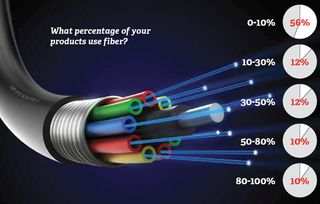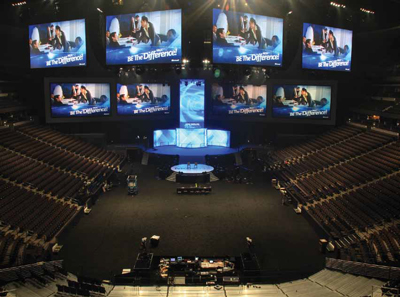At the 2011 Microsoft Global Conference in the Colorado
Convention Center, High Resolution paired a Spyder X20
with a 32x32 DVI Lightware router that included Dual-Link
DVI input and output boards to switch screens onstage plus 23
downstage monitors.Ask yourself this: What’s your fiber intake?
It’s time to take stock of what’s happening in the fiber optics market and how it can translate into real business for AV integrators and consultants.
The good news is that the increased bandwidth required for HD and even higher resolution is driving fiber optics sales and should provide an easier sell to customers when its future-proofing and infinite bandwidth capabilities are fully explained. In many cases, fiber is necessary to support uncompressed real-time digital video, and its distribution of video signals allow for an effective design.
“There are more and more Cat-5 solutions on the market but distances are limited when you want to achieve uncompressed signal quality,” said Blake Dudash, sales and marketing director at Lightware USA. “I see more accessories and devices with fiber as a platform.”
Lightware is coming out with a new line of multi-format matrices called 25G, which can handle multiple formats in addition to video, including digital and analog audio and video, USB/KVM, ethernet, RS-232 / RS-422, IR, and CEC . The 25G 160x160 modular frames with video I/Os are currently available.
“We also have an accessory line of modular extenders called MO DEX,” said Dudash. “With these, you can build your own custom multi-format transmitter and receiver, choosing your needed layer types to extend over a single fiber or twisted pair cable and used as standalone units or in conjunction with 25G.”
Today’s HDMI standards are capable of data speeds up to 10.2 Gbps, with DisplayPort 1.1 capable of speeds up to 10.8 Gbps. “When DisplayPort 1.2 comes out, the required bandwidth increases even higher to 21.6 Gbps, and our infrastructure is truly a future proof solution enabling you to go up to 25 Gbps,” he added. MO DEX and the Multi Layer Input / Output (I/O) cards for 25G will be available in December.
“Even some of the simplest applications include fiber for connecting basic laptops to projectors just because of distance,” noted Todd Kellison, sales engineer and manager for the Eastern U.S. at Opticomm- EMCORE. “Most government/ military installations already use it for security.”
Opti comm-EMCORE’s HDMX is a matrix router that can switch, route, and extend any input to any output. Interfaces include HDMI , DVI, 3G HD-SDI, component, composite, VGA, Fiber, and Cat-5/6. “The matrix comes in two sizes, 16x16 and 32x32, and is compatible with our VX Pro series, OTX series fiber extenders, and OTC series of HDBaseT Cat-5/6 extenders,” Kellison said.
Its next generation of Optiva DVI solution for distributing highresolution video over fiber, either point-to-point or point-tomultipoint, is capable of extending either analog or digital video at basically any resolution. The receiver, when in intelli-scale mode, will scale to the native resolution of the connected monitor, he explained. “We can transport resolutions of 1920x1200 and higher over long or short distances on one mutlimode or singlemode fiber. We also have the added feature of sending USB/serial data as well as analog and S/ PDIF audio with the video.”
Decisions, Decisions
The consensus is that fiber is an ideal choice for AV environments because it offers the capacity and reliability that will be imperative as the requirements for moving increased amounts of data continue to grow. But the election to propose or install fiber for AV integration should still be a measured one, taking into account the benefits of a carefully considered backbone.
>>> SCN Online Survey Vote on a new survey online today at avnetwork.com.

“More often than not, AV operators do not have the option of starting from scratch and must retrofit an existing facility that may or may not offer easy access for installing additional cables,” said Frank Jachetta, president of MultiDyne. “An advantage of fiber is that it can often be integrated affordably along with other utility cables such as power or video. Today, 100 strands of fiber can fit in a jacket no thicker than coax. Thus, by leveraging the massive bandwidth of fiber, even a few strands can go a long way toward fulfilling a variety of needs. However, encourage your client to install as many as possible. If they are thinking 64 strands then suggest 128. They will end up thanking you in the long term.”
The fiber or copper decision is nuanced. While it seems clear that the inherent benefits of fiber signals revolve around those characteristics found in an optical distribution system, mainly the use of light instead of electric signals to pass data, the decision to use copper versus fiber is a cost/benefit analysis which will consider the added cost of an optically based distribution solution versus the benefits provided by this type of platform, said Paul Hand, senior product manager at AMX.
There are several areas where the use of an optical transport layer will provide benefits over an alternative copper based solution. Among the benefits are those typically tied to optical transmission lines in general, including added security.
“Optical lines are significantly more difficult to tap, cut (without interruption of service), or otherwise tamper with,” Hand explained. “They also provide electrical isolation which prevents back channel communications possibilities when using single direction optical components.”
Government entities and industries with sensitive information such as medical and financial industries will find the most value in these aspects of fiber. Regarding electrical isolation, it’s impossible for transient voltages (damaging voltage levels often associated with lightning strikes) to pass between optically linked buildings or environments. Ground loops between connected environments are prevented, and lightning-prone environments will benefit as well.
“While most AV installs won’t be dealing with environments where flammable gasses or liquids may be prevalent, where video feeds are being run, the use of optical paths does eliminate any possibility of sparks on a distance run, which may be dangerous in certain environments,” Hand added.
In addition, there are noise immunity and size/ weight considerations. Even when compared to alternative category cable solutions, optical signals are the lightest, highest density solution available, especially when using multiple optical cable bundles.
Depending on the application, dozens or more optical cores, each with its own uncompressed high-definition video feed, can be run in the same size diameter cable as a typical Cat-5e. And perhaps the most compelling reason for the use of fiber, Hand argued, generally spanning all markets and applications, is the advantage of longer distances for pixel reproductions.
“As a true digital signal being transported over optical cable, if a fiber feed makes it with enough optical strength to the endpoint receiving device, the resulting image can and should be exactly the same as the original video the source device is providing,” he said. “Even with advances in category cable copper solutions utilizing HDBaseT technology, which are stretching the limits of category cable runs out to 100 meters for uncompressed digital video, fiber can easily extend video 10 times that length or more out to a full 1,000 meters.”
Hand points to AMX’s fiber-based matrix switching and transport line, the Epica DGX, as a premier optical distribution and transport platform. Offered in several sizes the Epica DGX family has been widely deployed across numerous applications including military command and control installations, emergency operations centers, financial centers, medical facilities, and university training environments.
The DGX fiber receivers feature SmartScale technology to automatically read each connected display’s EDID information and to intelligently scale the video output to match the display’s preferred resolution. “This eliminates a major headache for installers; that of varying source and destination resolutions, which many times forces source devices to distribute lower common resolutions and therefore poorer picture quality,” Hand explained. “SmartScale functionality allows source devices to be turned up to their highest resolution and allows as much video data through to each display based on that display’s native resolution.”
Show Me the Money
Once the glass is installed, fiber signal transport generally becomes a simple matter of plug and play. Whether the application involves centralized computing with multiple KVMs, video distribution, routing, conference rooms, or high-definition surveillance, etc., there are many options at various price points.
“The good news is that costs for the active components of fiber continue to decrease, making fiber solutions affordable to more customers,” Jachetta said. “For large installations, the cost of fiber often can be shared by multiple users within an organization, making fiber a cost-effective solution for any size operation.”
Despite lowered costs for fiber solutions, and although fiber has been available for a long time, there are still a lot of AV integrators who are reticent about discussing it with customers, Kellison suggested. “InfoComm has done a good job of education, but some integrators are shy about it because they just don’t know a lot about it.”
You don’t have to be scared of fiber optics, he advised. “It’s really not much different than a copper cable. In critical applications you have to think about points of failure but transmitter receivers are reliable.”
And when signal quality and integrity is the highest priority the cost of fiber is not always significantly higher than the alternative, especially considering the future proofing aspect.
“There is not a wireless internet hub that exceeds the capabilities of what the fiber optics infrastructure can do,” Dudash stated. “Some may have had bad experiences with it; fiber can break and is sometimes hard to get it the allotted space. But once laid and running, it’s pretty much there to stay.”
Karen Mitchell is a freelance writer living in Boulder, CO.
Through the Lens
Once upon a time, fiber optics conjured up the image of a challenging AV integration choice because it was both expensive and fragile. Now it’s far less daunting and much more flexible, literally and figuratively.
“The bend radius has improved and fiber termination has become so much easier and less expensive,” said Frank Jachetta of MultiDyne.
As with any electronic component, the decrease in cost over the last five years has rendered it a more advantageous path. “There will be an increase in the digital signage and military markets,” predicted Todd Kellison of Opticomm-EMCORE. “Military installations have become the majority of our business in the last couple of years and will always be a good market for us.”
Although fiber cable itself has hasn’t changed much, technology has marched on. “It’s been the electronics on each end that have lagged behind,” he added. “If manufacturers can get those electronic components to keep up with the next big technology innovation, that would make a big difference.”
The fiber cost decrease, halved or more over the last several years, has been matched by an upswing in accessibility and education about fiber solutions. “In many markets, fiber is the only way to go,” said Blake Dudash of Lightware USA. “My prediction is that we’ll see more fiber optics installations next year in government, medical, and rental and staging/live event projects.”
What’s the bottom line? “Once a time-consuming laboratory process, fiber can now be executed easily in any environment including those outdoors or on the side of the road, making it no more challenging to deploy than coax,” Jachetta said. “Five years from now, the sky will be the limit.”
—K.M.










